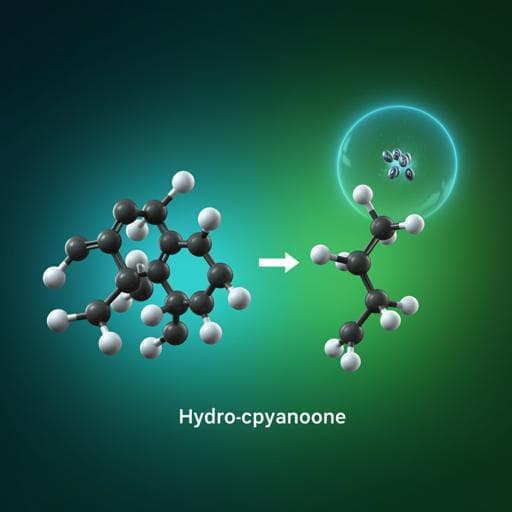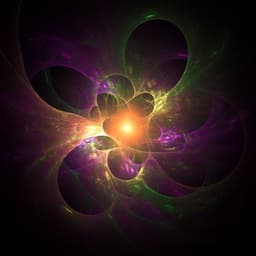
Chemistry
Electrocatalytic synthesis of heterocycles from biomass-derived furfuryl alcohols
X. Liu, B. Li, et al.
This groundbreaking research by Xuan Liu, Bo Li, Guanqun Han, Xingwu Liu, Zhi Cao, De-en Jiang, and Yujie Sun introduces an innovative electrocatalytic Achmatowicz reaction. It effectively converts biomass-derived furfural into hydropyranones using a unique heterogenized nickel electrocatalyst, shedding light on the intricate reaction mechanisms involved.
~3 min • Beginner • English
Introduction
The study addresses the challenge of converting abundant, sustainable biomass into high-value heterocyclic motifs used in biologically active molecules and pharmaceuticals. Traditional biomass valorization has focused on fuels and commodity chemicals with limited economic competitiveness at scale, whereas pharmaceutical applications could be profitable even at small scale. The Achmatowicz reaction, which transforms furfuryl alcohol (readily obtained from industrially available furfural) into substituted dihydropyranone acetals, provides a promising route. However, conventional methods rely on stoichiometric, often toxic or expensive oxidants and organic solvents, and can require harsh conditions. The research question is whether an electrocatalytic strategy operating under ambient, aqueous conditions can efficiently and selectively drive the Achmatowicz rearrangement using water as the oxygen source, thereby offering a greener, economical pathway to heterocycles from biomass-derived furfuryl alcohols.
Literature Review
Prior Achmatowicz strategies used chemical oxidants such as Br2/MeOH with acid hydrolysis (yield ~73%), N-bromosuccinimide (NBS) at 0 °C (65%), m-CPBA in CH2Cl2 (48%), dimethyldioxirane in acetone (95%), and biocatalytic monooxygenase systems (82%). These methods often require stoichiometric oxidants, organic solvents, and additional steps. Electrochemical attempts since the 1950s achieved methoxylation of furfuryl alcohol in MeOH with bromide salts (NH4Br/NaBr) at low temperatures and high voltages (e.g., 4.8 V), followed by acid hydrolysis to obtain hydropyranone; faradaic efficiencies ranged from ~5% to 77%, with limitations including bromide requirement, organic solvents, low temperatures, high voltages, and post-treatment. Direct furanoxonium pathways required very high voltages. Thus, a breakthrough electrocatalytic approach in water without halides and post-treatments has been lacking.
Methodology
Catalyst preparation: A ligand film is first formed by photo-induced polymerization of 5,5′-divinyl-2,2′-bipyridine (dvbpy). dvbpy (20 mg in 0.5 mL isopropanol with 10% benzoyl peroxide) is drop-cast (10 μL per side) onto acid-cleaned carbon paper (1×1 cm) and irradiated with 250 nm UV light (15 min per side, ~10 cm distance) to form DVBP. Metalation is achieved by immersing DVBP in 100 mM Ni(OTf)2 in MeCN overnight to afford Ni-DVBP; electrodes are rinsed with MeCN.
Characterization: FT-IR shows retention of bipyridyl vibrations and decreased C=C/C=N ratio consistent with polymerization. Raman spectra display a new band at 396 cm−1 assigned to Ni–N stretching. SEM reveals rough, porous morphology; EDX confirms Ni and N. XPS indicates Ni2+ (Ni 2p3/2 at 855.7 eV, 2p1/2 at 873.2 eV with satellites) and pyridine N (N 1s at 399.2 eV). Electrochemistry on glassy carbon in MeCN shows a pseudo-reversible Ni3+/2+ couple at −0.31 V vs Fc+/0; peak currents scale linearly with scan rate consistent with immobilization.
Electrochemical testing: Catalysis is conducted in a three-electrode H-cell with Ni-DVBP working electrode (typically on carbon paper), Ag/AgCl (sat. KCl) reference, and carbon rod or Pt counter, in 0.1 M phosphate buffer (KPi) at pH 7 unless noted. CVs demonstrate lower O2 evolution onset on Ni-DVBP vs controls and rapid anodic current onset (~0.9 V vs Ag/AgCl) upon adding 10 mM furfuryl alcohol.
Electrolysis conditions: Bulk electrolysis (Method A) at fixed potentials (1.1–1.8 V vs Ag/AgCl) is used to quantify product distributions by HPLC. Reusability is assessed over four consecutive cycles. Product isolation is performed (Method B) and flow-electrolyzer (Method C) enables gram-scale synthesis with simple workup.
Substrate scope: Furfuryl alcohol derivatives with varied substituents at the hydroxymethyl position and at the 5′-position are tested at 1.4 V vs Ag/AgCl in pH 7 KPi; yields are compared to m-CPBA oxidation.
Mechanistic studies: DFT calculations (Gaussian 09) with B3LYP functional; LANL2DZ ECP for Ni and 6-31G(d,p) for H, C, O, N, followed by single-point refinement at 6-311+G(2df,2p). Computational hydrogen electrode is used for electrochemical steps; reaction free energies computed as ΔG=ΔE+ΔEZPE−TΔS. A mononuclear model [(bpy)NiII(H2O)2]2+ is used to represent Ni sites. IR comparisons of Ni-DVBP, furfuryl alcohol, and Ni-DVBP after FA exposure probe binding via shifted vibrational bands.
Key Findings
- Electrocatalytic Achmatowicz reaction in water: At 1.4 V vs Ag/AgCl in 0.1 M phosphate buffer (pH 7), Ni-DVBP achieves 96% yield of hydropyranone with only 2% furfural byproduct; faradaic efficiency (FE) is 84% at 10 mM substrate and increases to 93% at 50 mM.
- pH selectivity control: At pH 5 (0.1 M acetate buffer) and 1.3 V, hydropyranone yield is 92% (FE 63%). At pH 10 (0.2 M carbonate buffer) and 1.0 V, hydropyranone is negligible (3%) while furfural dominates (96%).
- Superiority over controls: DVBP alone and pristine carbon paper at 1.4 V (pH 7) show much lower performance (DVBP: 65% hydropyranone, 34% furfural, FE 21%; carbon paper: 20% hydropyranone, 77% furfural, FE 18%), highlighting Ni’s catalytic role.
- Kinetics and robustness: HPLC tracking shows hydropyranone forms from the onset of electrolysis with minimal furfural (<2%). The same Ni-DVBP electrode maintains near-complete conversion and high yield over four consecutive cycles.
- Scale-up: Flow electrolysis provides gram-scale hydropyranone with 84% isolated yield and simple workup. Chemical methods (NBS, m-CPBA) give 73% and 82% yields, respectively, for comparison.
- Substrate scope: High yields obtained across diverse substituents at the hydroxymethyl position (e.g., methyl 93%, dimethyl, propyl, benzyl, phenethyl ~87–93%). Electronic effects: p-fluorophenyl (electron-withdrawing) at the alcohol-bearing carbon gives 76% vs ~90% for less withdrawing aryls; m-CPBA gives 66–73% without strong differentiation, suggesting different mechanisms. 5′-Substitution: 5′-Me gives 82% (slight steric effect); bulky 5′-p-chlorophenyl blocks conversion at 1.4 V but affords 84% at 1.8 V, indicating a potential-dependent mechanistic switch. Sensitive groups (e.g., vinyl, ester relevant to natural product syntheses) are tolerated (e.g., 2m: 65–71% range; specialized substrates 2a, 2g, etc., often comparable or superior to m-CPBA).
- Potential dependence: On Ni-DVBP, hydropyranone yields are 79% (1.1 V), 87% (1.2 V), 92% (1.3 V), and 96% (1.4 V), with nearly full FA conversion at low potentials; carbon paper shows negligible activity at 1.1–1.2 V and <20% yield at 1.3–1.4 V. At 1.8 V, Ni-DVBP and carbon paper give 93% and 65% hydropyranone, respectively, but with reduced FE (67% and 53%), due to O2 evolution competition.
- Mechanism insights (DFT and spectroscopy): FA binds to NiII, replacing H2O by −0.21 eV (favorable). Oxidation/deprotonation triggers interaction of Ni–OH with the FA 5′-carbon (requires +0.79 eV), followed by water coordination and hydroxide migration to FA (energy of the next intermediate is −0.37 eV relative to the prior), and a second oxidation/deprotonation leading to a key Achmatowicz intermediate (energetically downhill to −0.60 eV). IR spectra show shifts in FA and Ni-DVBP bands consistent with FA ligation. An alternative oxygen-atom-transfer route via Ni-oxyhydroxide requires much higher energies for two oxidations (+2.62 and +2.02 eV) and suffers from competing O2 evolution, aligning with experimental potential dependence.
- Catalyst characteristics: Immobilized molecular Ni sites in a porous polymeric bipyridyl film enable low-onset-potential FA oxidation (~0.9 V vs Ag/AgCl), high selectivity and FE, and operational robustness.
Discussion
The work demonstrates that unsaturated, immobilized nickel sites within a polymerized bipyridyl film can mediate the Achmatowicz rearrangement efficiently in neutral aqueous media, using water as both solvent and oxygen source. The intimate binding of furfuryl alcohol to the Ni center enables intramolecular hydroxide transfer at low applied potentials, which circumvents the need for stoichiometric oxidants and harsh conditions. Potential- and pH-dependent selectivity provide synthetic control: neutral to mildly acidic pH favors hydropyranone formation, whereas alkaline conditions yield furfural. Compared to traditional electro-oxidations requiring bromide salts and organic solvents (and post-hydrolysis), this electrocatalytic approach delivers higher selectivity, comparable or better yields, greener conditions, and valuable H2 co-generation at the counter electrode. Mechanistic evidence (DFT and IR) supports a low-potential pathway involving FA ligation and hydroxide migration (Mechanism 1), while at higher potentials a more general oxygen-atom transfer pathway (Mechanism 2) can operate but with lowered faradaic efficiency due to O2 evolution, explaining substrate steric sensitivity at low potential and recovery of reactivity at higher potential.
Conclusion
A heterogenized nickel electrocatalyst (Ni-DVBP) prepared by photo-induced polymerization of a bipyridyl ligand followed by Ni incorporation enables an efficient, selective, and robust electrocatalytic Achmatowicz reaction in water, with water serving as the oxygen source. The method achieves up to 96% yield and 93% faradaic efficiency in neutral phosphate buffer, exhibits broad substrate scope with functional-group tolerance, is reusable, and scalable to gram quantities with simple workup. DFT and spectroscopic analyses reveal a low-potential mechanism involving substrate ligation and intramolecular hydroxide transfer from Ni to the 5′-position, distinct from traditional oxygen-atom-transfer routes that dominate at higher potentials. The approach eliminates toxic oxidants and organic solvents and co-produces H2, offering a green, atom-efficient route to valuable hydropyranones relevant to pharmaceutical synthesis. The ligand-polymerization strategy should be generalizable to other first-row transition-metal electrocatalysts with unsaturated coordination environments, inviting future exploration of asymmetric variants, enantioselective versions, extended substrate classes, and integration with continuous-flow electrochemical systems.
Limitations
- Steric sensitivity at low potentials: Bulky 5′-substituents (e.g., p-chlorophenyl) suppress the reaction at 1.4 V vs Ag/AgCl, requiring higher potential (1.8 V) that reduces faradaic efficiency due to competing O2 evolution.
- Faradaic efficiency depends on substrate concentration and potential; at high potentials FE drops (e.g., 67% at 1.8 V on Ni-DVBP).
- Alkaline conditions (pH 10) favor over-oxidation to furfural, limiting hydropyranone formation under those conditions.
- Stability was demonstrated over four cycles; longer-term durability and turnover numbers beyond this were not reported.
- Mechanistic modeling uses a simplified mononuclear Ni model and does not capture full heterogeneity of the polymer film; direct observation of all intermediates is inferred from DFT and IR shifts rather than isolated species.
Related Publications
Explore these studies to deepen your understanding of the subject.







